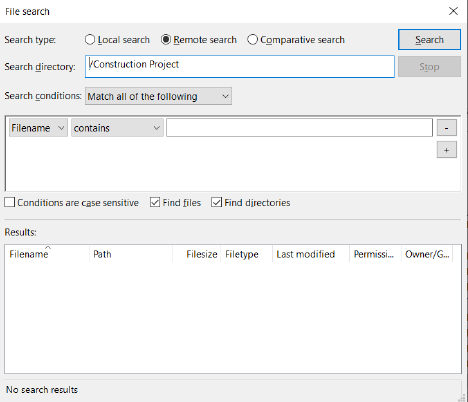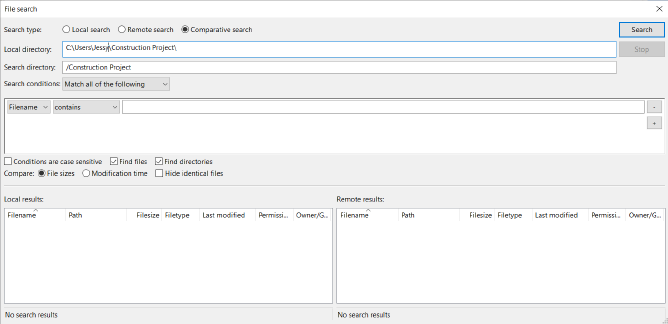Below you find a step by step guide, if you prefer you can watch our How to Search for Files video tutorial.
Search for files
If you need to find a particular file on the local machine or remote server:
- Connect to the server in FileZilla Pro.
- In the main menu, click on Server > Search remote files
Alternatively, press the F3 key.
The File search window will be displayed.
- Choose the search time from the Search type radio buttons. Pick Local search if you
want FileZilla Pro to look on your local computer (the one that you’re using), or Remote
search to look on the remote server that FileZilla Pro is currently connected to. Select
Comparative search to simultaneously search both your local computer and the remote
server. The results are then presented and compared. - Enter the directory that you want to search in. The search is recursive, meaning that
FileZilla Pro will also search all sub-directories in the specified directory.
For example, enteringD:\would cause FileZilla Pro to search all of D:, but entering D:\Program Files would cause FileZilla Pro to only search in theProgram Filesdirectory, its sub-directories, their subdirectories, and etc. In the comparative search type you have to enter both the local and remote directories. - Select a search method from the Search conditions drop down list:
- Match all of the following: FileZilla Pro will only show a file if it meets every single search condition that you’ve set.
- Match any of the following: FileZilla Pro will display a file if it meets one or more of the search conditions that you’ve set.
- Match none of the following: FileZilla Pro will only display a file if it doesn’t meet the criteria of every single search condition that you’ve set.
- Match not all of the following: FileZilla Pro will display all files that don’t meet the criteria of one or more of the search conditions that you’ve set.
- Set at least one search condition.
In the first column, select what FileZilla should search on- Filename: Look at the name of the file, including its extension (eg. .doc). Requirements:
alphanumeric characters; can include punctuation.
- Filesize: Look at the size of the file. Requirements: numeric characters only.
- Path: Look at the names of the directory and subdirectories in which the file is
found. Requirements: alphanumeric characters; can include punctuation.
- Date: Look at the date on which the file was created or last modified. Requirements:
Numeric characters in YYYY-MM-DD format. For example, April 1, 2019
would be entered as 2019-04-01. Use hyphens as separators.
In the second column, select the type of search to use:
- contains: Search for files and directories in which the name includes
the text entered. For example, searching on ‘word’ using this option could return both My Word File.docx and Sword-and-sorcery.epub.
- is equal to: Search for files and directories with a name that exactly
matches the text entered. For example, searching on ‘word.docx’
would only return files named word.docx.
- begins with: Search for files and directories with a name starting with
the text entered. For example, searching on ‘word’ using this option
could return Word of the Day.xls but not My Word File.docx or Swordand-
sorcery.epub.
- ends with: Search for files and directories with a name that ends with
the text entered. This includes the filename and extension; for example,
searching on ‘doc’ could return caradoc and hustle.doc.
- matches regex: Use regular expressions in your search criteria.
Available search parameters:
- .: use a period to substitute for a single character. For example,
searching onf.llcan return fell.txt and fill.txt.
- *: use an asterisk after a character to search for any number of
that character in the specified place in the string. For example,
searching ontex*tcan return tet, text, texxt, texxxxxxxxt, etc.
- ?: use a question mark after a character to search for 0 or 1
uses of that character in the specified place in the string. For
example, searchingtex?tcan return tet or text, but not texxt.
- ^: use a caret mark to search for all file names beginning with
the character(s) after it. For example, searching on ^t would
return all files with names beginning with a t.
- $: use a dollar sign to search for all file names ending with
the character(s) before it. For example, searching on b$ would
return all files with names ending with a b.
- \: use a backslash character to ‘escape’ the following character,
telling FileZilla Pro to treat it as a normal character and not as a
search expression. For example, if you want to search for text
files, you could search on \.txt.
- .: use a period to substitute for a single character. For example,
- does not contain: Search for files and directories that do not have the
entered text in any part of their name. - greater than: Search for files larger than the specified size.
- equals: Look for files at the specified size, or created or modified on
the date entered. This is exact; FileZilla Pro doesn’t include a margin
of error for this option. - does not equal: Look for files that are of any but the specified size,
creation or modification date. - less than: Search for files smaller than the specified size.
- before: Search for files created or modified before the specified date.
- after: Search for files created or modified after the specified date.
In the third column, enter the search parameters for FileZilla to use:
- Filename and Path: Use alphanumeric characters; can include punctuation.
- Filesize: Use numeric characters only.
- Date: Use numeric characters in YYYY-MM-DD format with hyphens as separators.
For example, April 1, 2019 would be entered as 2019-04-01.
Create another search condition, click on the + button to the right and underneath
the bottom condition.
Delete a search condition you’ve created, click on the – to its right. - Filename: Look at the name of the file, including its extension (eg. .doc). Requirements:
- To make the search case-sensitive – for example, if you’ve entered lower-case letters,
to ensure that FileZilla Pro only returns results using the lower-case string and not
a combination of upper- and lower-case, or all upper-case – tick the Conditions are
case sensitive checkbox. - To find files that match the search criteria, tick the Find files checkbox.
- To find directories that match the search criteria, tick the Find directories checkbox.
- In the comparative search the comparison is based on file sizes but you can change
to compare based on the file modification time. - Also in the comparative search tick Hide identical files to hide the files are identical
according to the comparison criteria. - Click on Search to start the search process.
The video tutorial below shows how to search files and how to use comparative search with FileZilla and FileZilla Pro.

